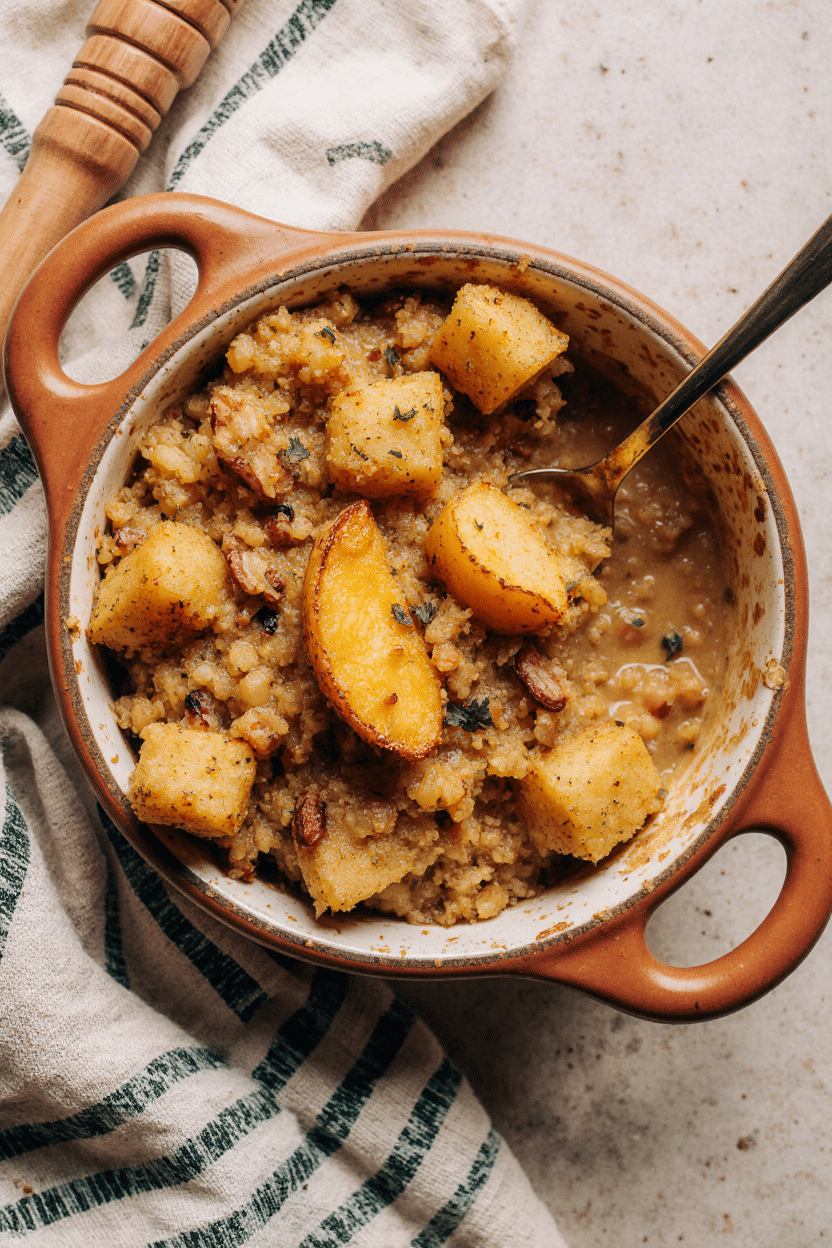The rich flavor of fried plantains, garlic, and savory bacon come together in this traditional Puerto Rican take on stuffing. Mofongo Stuffing is a dish born from the vibrant culture of the Caribbean and perfect for adding bold, island-inspired flavors to your holiday table.
While traditional mofongo is typically served alongside meats like steak or shrimp, this version is transformed into a festive and moist stuffing with the help of broth and a hint of sofrito. It’s an unforgettable dish that bridges cultures—perfect for those who want to honor their heritage or simply experience a taste of Puerto Rico with their turkey this year.
Full Recipe:
-
4 green plantains, peeled and cut into 1-inch pieces
-
6 slices thick-cut bacon, chopped
-
1 cup pork rinds (chicharrón-style if possible)
-
4 cloves garlic, minced
-
½ cup chicken or vegetable broth
-
2 tablespoons olive oil
-
½ teaspoon ground black pepper
-
Salt to taste
-
Optional: 1 teaspoon sofrito (for enhanced flavor)
Directions:
-
In a deep skillet, heat oil over medium-high heat and fry the plantain chunks in batches until golden and tender (about 5-7 minutes per batch). Drain on paper towels.
-
In another skillet, cook chopped bacon until crispy. Set aside, reserving a tablespoon of bacon fat.
-
Combine fried plantains, garlic, bacon, and pork rinds in a food processor. Add the reserved bacon fat and pulse until coarsely mashed. (You can also mash by hand using a potato masher or pilón.)
-
Transfer mixture to a large bowl and add broth gradually while folding with a spoon or spatula until the stuffing is moist and holds together.
-
Add salt, pepper, and sofrito (if using) to taste.
-
Transfer the mixture to a baking dish, cover with foil, and bake at 350°F (175°C) for 20–25 minutes until hot and slightly crisped on top.
Prep Time: 15 minutes | Cooking Time: 30 minutes | Total Time: 45 minutes
Kcal: 290 kcal | Servings: 8 servings
History and Origin
Mofongo has long been a staple of Puerto Rican cuisine, and its origins can be traced back to African, Spanish, and Taino influences. The core of mofongo—mashed green plantains—is a direct descendant of fufu, a starchy African dish made with yams or cassava and often pounded into a dough-like consistency. When enslaved Africans were brought to the Caribbean, they adapted fufu using local ingredients, namely plantains, which were abundant and versatile.
Over time, the Taino people and Spanish colonizers introduced their own ingredients and cooking methods, including the addition of garlic, olive oil, and pork—often in the form of chicharrones (crispy pork cracklings). The result was a dish that blended bold flavors with a hearty texture, cooked and served in a pilón, a wooden mortar and pestle still used today in many Puerto Rican kitchens.
The idea of turning mofongo into a stuffing is relatively modern, driven by Puerto Rican families living in the mainland U.S. looking to honor their roots during holidays like Thanksgiving. It symbolizes the best of both worlds: honoring American traditions while embracing the deep culinary identity of Puerto Rican heritage.
Variations and Adaptations
Mofongo itself is already a versatile dish. It can be served as a side or main course, filled with anything from shrimp to roast chicken. When adapted into stuffing, there’s even more room for creativity.
Some home cooks keep it traditional, using chicharrón or bacon for depth of flavor, while others opt for vegetarian or vegan versions by replacing pork with mushrooms, caramelized onions, or smoky tempeh. The broth can easily be swapped for a vegetable base, and extra seasonings like sofrito, cilantro, or adobo can bring an extra punch of authenticity and flair.
In the Dominican Republic, a similar dish called mangú uses boiled instead of fried plantains and typically omits pork. You can pull inspiration from that approach if you’re looking for a softer, lighter version. Similarly, in Cuban cuisine, plantains are often served with garlic and citrus mojo sauce—incorporating that flavor profile into your stuffing could add a refreshing twist.
Nutritional Information
When it comes to nutrition, Mofongo Stuffing is a mixed bag—offering both indulgent and wholesome elements depending on your adaptations.
-
Calories: One serving of traditional mofongo stuffing (with bacon and pork rinds) contains around 290–320 kcal, primarily from the fried plantains and pork fat.
-
Carbohydrates: Plantains are starchy and rich in complex carbs—expect 35–40g of carbs per serving. However, they have a low glycemic index compared to white bread.
-
Protein: The bacon and pork rinds contribute 8–10g of protein per serving.
-
Fats: Expect 15–20g of fat, depending on how much oil and pork you use. Choosing leaner cuts or baking instead of frying can reduce this.
-
Micronutrients: Plantains are a good source of potassium, magnesium, and vitamin C, while garlic offers antioxidants and anti-inflammatory compounds.
To make it lighter, reduce or eliminate the pork, opt for baking over frying, and increase the use of herbs or vegetable broth for flavor without added fat.
Serving Suggestions and Pairings
Mofongo Stuffing pairs beautifully with a traditional roast turkey, but it also stands up well alongside roasted chicken, pork loin, or glazed ham. For a vegetarian spread, try serving it with roasted vegetables, stuffed squash, or a spiced lentil loaf. The hearty and garlicky profile makes it versatile across cuisines.
As for drinks, consider serving it with a crisp white wine like a Sauvignon Blanc or Albariño, which will cut through the richness. For a non-alcoholic option, a tart hibiscus tea (agua de jamaica) or sparkling lime soda provides a refreshing contrast.
If you’re planning a themed Puerto Rican or Caribbean-inspired meal, consider serving Mofongo Stuffing with:
-
Arroz con Gandules (rice with pigeon peas)
-
Pastelón (Puerto Rican plantain lasagna)
-
Coquito (a coconut milk eggnog-like drink) for dessert
Tips and Tricks for Success
-
Choose firm green plantains: These are less sweet and more starchy, which is perfect for achieving the right texture. Ripe plantains will turn the stuffing too soft and sweet.
-
Don’t skip the garlic: Garlic is key to the dish’s depth of flavor. Freshly minced garlic is best, but if you’re in a rush, pre-minced from a jar will do.
-
Control your texture: If you like a chunkier stuffing, mash by hand or pulse briefly in a food processor. For smoother consistency, blend more thoroughly.
-
Make ahead: You can prep the mashed plantain base a day in advance, then reheat it with broth and bake before serving.
-
Use foil while baking: This prevents the top from drying out too fast. If you want a slightly crisp top layer, remove the foil in the last 5–10 minutes of baking.
Potential Health Benefits
Despite being a comfort food at heart, Mofongo Stuffing does have some nutritional redeeming qualities:
Advertisement
-
Plantains are high in resistant starch, which supports gut health and helps regulate blood sugar levels. They’re also rich in vitamin A and fiber.
-
Garlic is known for its immune-boosting and anti-inflammatory properties. It has been shown to reduce blood pressure and improve cholesterol levels.
-
Olive oil, if used instead of pork fat, brings heart-healthy monounsaturated fats into the dish.
-
Pork rinds, while indulgent, are high in collagen and protein—though best enjoyed in moderation.
By adapting the ingredients and cooking method, this stuffing can go from indulgent to balanced while still retaining its traditional flavors.
Conclusion
Mofongo Stuffing is more than just a side dish—it’s a celebration of cultural identity, culinary creativity, and bold, unforgettable flavor. Whether you’re bringing it to a Thanksgiving table or enjoying it as a stand-alone dish, it’s guaranteed to surprise and delight. With its crispy edges, garlicky depth, and savory plantain base, it offers a fresh perspective on what stuffing can be.
So next time you’re planning a holiday meal or just feeling adventurous in the kitchen, give this Puerto Rican classic a spot on your plate. Your taste buds—and your dinner guests—will thank you.





